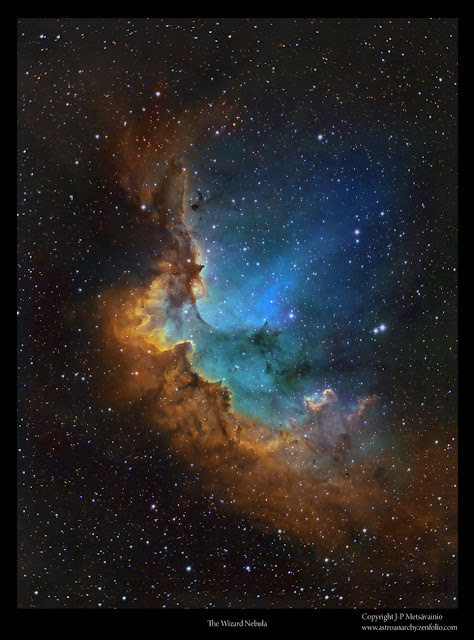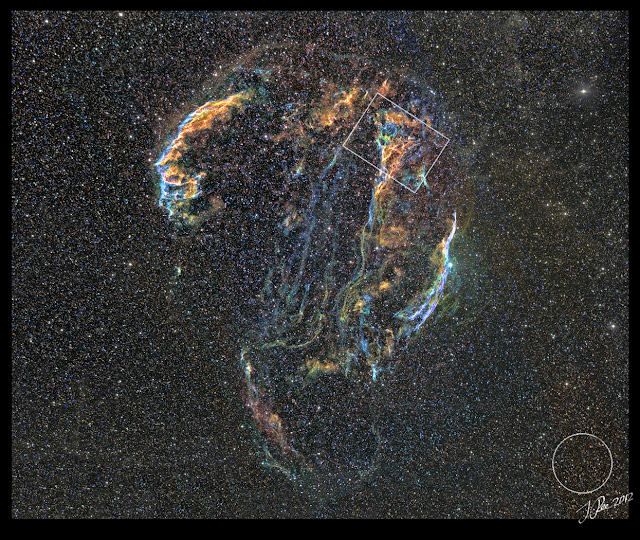COPYRIGHT, PLEASE NOTE
All the material on this website is copyrighted to J-P Metsavainio, if not otherwise stated. Any content on this website may not be reproduced without the author’s permission.
BUY A MUSEUM QUALITY POSTER
BUY A POSTER:https://astroanarchy.zenfolio.com/
Wednesday, May 22, 2013
Filaments of the Veil nebula, starless view
One of my starless astronomical image experiences, the Pickering's Triangle in Cygnus supernova remnant.
This area of the nebula is filled with colorful filaments, ionized sulfur and hydrogen are seen as green, golden hues, ionized oxygen can be seen as blue.
The complexity of filaments stands out nicely in this starless image.
An original image with the stars
Original blog post about this image, with the technical details, can be seen here:
http://astroanarchy.blogspot.fi/2012/11/pickerings-triangle-project-finalized.html
Orientation in the Veil Nebula SNR
INFO
Exposure and processing details
This area of the nebula is filled with colorful filaments, ionized sulfur and hydrogen are seen as green, golden hues, ionized oxygen can be seen as blue.
The Pickering's Triangle with a suppressed stars
A detail of the Veil Nebula supernova remnant
The complexity of filaments stands out nicely in this starless image.
An original image with the stars
Image is in mapped colors, from the emission of ionized elements, R=Sulfur, G=Hydrogen and B=Oxygen.
http://astroanarchy.blogspot.fi/2012/11/pickerings-triangle-project-finalized.html
Orientation in the Veil Nebula SNR
Area of interest is marked as a white rectangle, the apparent size of the Moon can be seen at lower right corner.
INFO
Pickering's Triangle, Simeis 3-188, is a small part of the Veil Nebula supernova remnant in constellation Cygnus.
Veil Nebula is a cloud of ionized gas and dust, leftovers from an exploded star. The star went off some 5000-8000 years ago at distance of about 1470 light years. This, relatively faint target, is difficult to image due to the large angular diameter, about three degrees, and a dense star field.
Exposure and processing details
Processing work flow:
Image acquisition, MaxiDL v5.07.
Stacked and calibrated in CCDStack2.
Levels, curves and color combine in PS CS3.
Optics, Meade LX200 GPS 12" @ f5
Camera, QHY9
Guiding, SXV-AO, an active optics unit, and Lodestar guide camera 8Hz
Image Scale, ~0,8 arc-seconds/pixel
15 x 1200s exposures for the H-alpha, emission of ionized Hydrogen = 5h
9 x 1200s exposures for the O-III, emission of ionized Oxygen = 3h
4x1200s exposures for the S-II, emission of ionized Sulfur = 1h 20min.
Labels:
Narrowband color images
Sunday, May 19, 2013
Never lose your sense of wonder!
Just a little reminder...
The Bubble Nebula
I shot this image of the Bubble Nebula back in 2009, large images and more info in this blog post:
http://astroanarchy.blogspot.fi/2011/03/bubble-nebula-reprocessed.html
Thursday, May 16, 2013
An experimental starless version of the Wizard nebula,
I like to make starless versions of my astronomical images now and then. They'll show the actual nebula better and have a kind of mystique feel.
Human brains has a tendency to form some quasi logical shapes out of cloud of random dots, like stars in this case. Without stars, the shapes in a gas cloud stands out much better.
A starless Sharpless 142 (Sh2-142), the Wizard Nebula
In constellation CepheusImage with a suppressed stars, click for a large image.
Original image with a technical details can be seen in THIS blog post.
Image with the stars

Info
NGC 7380 is a catalog number of the open star cluster inside Wizard nebula, SH2-142.
Nebula locates in constellation Cepheus, about 7000 light years from my home.
Technical details
Processing work flow:
Image acquisition, MaxiDL v5.07.
Stacked and calibrated in CCDStack.
Deconvolution with a CCDSharp, 30 iterations at 50% weight.
Levels, curves and color combine in PS CS3.
Telescope, Meade LX200 GPS 12" @ f5
Camera, QHY9 Guiding, SXV-AO @ 6,5Hz
Image Scale, 0,75 arcseconds/pixel
Exposures H-alpha 15x1200s, binned 1x1
S-II 1x1200s, binned 4x4
O-III 1x1200s, binned 4x4
Beside data here, a color information from an older wide field image is used.
Image can be seen here: http://astroanarchy.blogspot.fi/2011/02/sh2-142-wizard-nebula-wide-field.html
Labels:
research and development
Tuesday, May 14, 2013
Universe, rated by stars?
Just little something...
Rated universe, how many stars?
I used my image of a globular cluster NGC 6752 for the poster. Original image and technical details can be found HERE.
Rated universe, how many stars?
I used my image of a globular cluster NGC 6752 for the poster. Original image and technical details can be found HERE.
Sunday, May 12, 2013
A starless Melotte 15 in IC 1805, the Heart Nebula
For some reason, I like to make starless versions of my astronomical images now and then. They'll show the actual nebula better and have a kind of mystique feel.
Human brains has a tendency to form some quasi logical shapes out of cloud of random dots, like stars in this case. Without stars, the shapes in a gas cloud stands out much better, I think.
A starless Melotte 15 in IC 1805
Image with a suppressed stars, click for a large image.
Original image with a technical details can be seen in THIS blog post.
Image with the stars
Melotte 15 area in IC 1805, the Heart Nebula
Original image with a technical details can be seen in THIS blog post.
INFO
The "Heart Nebula", IC1805 locates about 7500 light years away in constellation Cassiopeia. This is an emission nebula showing glow of ionized elements in a gas cloud and some darker dust lanes.
In a very center of the nebula, lays Melotte 15, it contains few very bright stars, nearly 50 times mass of our Sun, and many dim ones. The solar wind, a radiation pressure, from massive stars makes the gas twist to a various shapes.
Technical details
Processing work flow:
Image acquisition, MaxiDL v5.07.
Stacked and calibrated in CCDStack2.
Levels, curves and color combine in PS CS3.
Optics, Meade LX200 GPS 12" @ f5
Camera, QHY9
Guiding, SXV-AO, an active optics unit, and Lodestar guide camera 8Hz
Image Scale, ~0,8 arc-seconds/pixel
18 x 1200s exposures for the H-alpha, emission of ionized Hydrogen = 6h
Thursday, May 9, 2013
Dead Stars Society, a collection of passed away stars
I made a poster format presentation out of my photos of exploded stars. In this collection, there are two types of dead stars, Planetary Nebulae and Supernova remnants. Images are not in scale.
Individual images, with some information, can be found from my portfolio: http://astroanarchy.zenfolio.com/
Dead Stars Society
Planetary Nebulae & Supernovae
Note. A large image, 6MB. Images are not in scale.
Labels:
Narrowband color images,
nebula
Monday, May 6, 2013
New collection of my B&W images
I have a gray scale version from all of my astronomical images. The camera used, QHY9, is a cooled astronomical camera and it has a gray scale CCD-sensor. Color images are made by shooting the same target at least three times, with different filters. Three images are then combined to a RGB-color image.
Due to that, I have a gray scale version from every target. Usually the light emitted by ionized Hydrogen, H-alpha, has most details and I made a collection out of them.
A high resolution, gray scale, image collection in my portfolio, please have a look:
(Second folder from top left)
The Elephant's Trunk Nebula in IC 1396, more info and a color version in this blog post.
You can buy a photographic print from any image at first two folders in my portfolio, http://astroanarchy.zenfolio.com/
All prints will be real photographic prints on photo paper. For the most exclusive result, metallic paper can be used.
Metallic prints give a distinctive look to most color shots, black & white and sepia images are particularly effective. With its glossy finish and metallic appearance, it represents another dimension for creating images with exceptional interest and depth. Metallic paper adds stunning visual impact and a contemporary flair to photos.
If you don't want to use the web shop or want images be framed, signed and numbered, please contact directly to me by email: astroanarchy (at) gmail.com
If you don't want to use the web shop or want images be framed, signed and numbered, please contact directly to me by email: astroanarchy (at) gmail.com
Subscribe to:
Comments (Atom)
















